
Symphyotrichum novae-angliae is a species of flowering plant in the aster family (Asteraceae) native to central and eastern North America. Commonly known as New England aster, hairy Michaelmas-daisy, or Michaelmas daisy, it is a perennial, herbaceous plant usually between 30 and 120 centimeters tall and 60 to 90 cm wide.

Symphyotrichum is a genus of over 100 species and naturally occurring hybrids of herbaceous annual and perennial plants in the composite family, Asteraceae, most which were formerly treated within the genus Aster. The majority are endemic to North America, but several also occur in the West Indies, Central and South America, as well as one species in eastern Eurasia. Several species have been introduced to Europe as garden specimens, most notably New England aster and New York aster.

Symphyotrichum lateriflorum is a species of flowering plant in the aster family (Asteraceae). Commonly known as calico aster, starved aster, and white woodland aster, it is native to eastern and central North America. It is a perennial and herbaceous plant that may reach heights up to 120 centimeters and widths up to 30 centimeters.

Symphyotrichum sericeum is a species of flowering plant in the family Asteraceae native to central North America. Commonly known as western silver aster, western silvery aster, and silky aster, it is a perennial, herbaceous plant that may reach 70 centimeters tall. Its flowers have purple ray florets and pink then purple disk florets, and its leaves are firm and silvery-green.

Symphyotrichum defoliatum is a species of flowering plant in the family Asteraceae known by the common name San Bernardino aster. It is endemic to Southern California where it grows in grasslands and meadows, and it is of conservation concern.

Symphyotrichum frondosum is a species of flowering plant in the family Asteraceae native to western North America. Commonly known as short-rayed alkali aster, it is an annual or perennial herbaceous plant that may reach 140 centimeters tall.

Symphyotrichum greatae is a species of flowering plant in the family Asteraceae endemic to California and known by the common name Greata's aster.
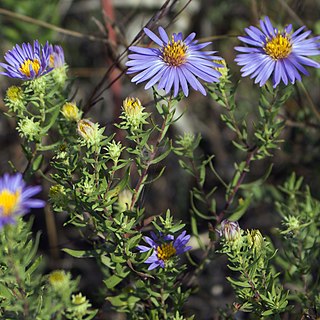
Symphyotrichum oblongifolium, commonly known as aromatic aster or oblong-leaved aster, is a species of flowering plant in the family Asteraceae and is native to parts of the eastern and central United States. It is an uncommon herbaceous perennial that reaches heights of 10–80 centimeters and blooms August–November with many flower heads in various shades of purple.

Symphyotrichum falcatum is a species of flowering plant in the family Asteraceae. Commonly called white prairie aster and western heath aster, it is native to a widespread area of central and western North America.

Symphyotrichum dumosum is a species of flowering plant of the family Asteraceae commonly known as rice button aster and bushy aster. It is native to much of eastern and central North America, as well as Haiti and Dominican Republic. It is a perennial, herbaceous plant that may reach a height of 1 meter.

Symphyotrichum patens, commonly known as late purple aster or spreading aster, is a perennial, herbaceous plant found in the eastern United States.
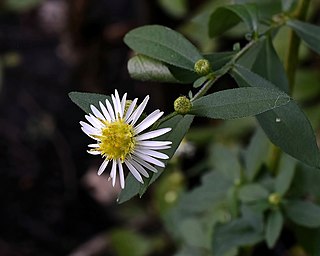
Symphyotrichum ontarionis is a species of flowering plant in the family Asteraceae native to eastern North America. Commonly known as Ontario aster and bottomland aster, it is a perennial, herbaceous plant that may reach heights of 120 centimeters. Each flower head has many tiny florets put together into what appear as one.

Symphyotrichum racemosum is a species of flowering plant native to parts of the United States and introduced in Canada. It is known as smooth white oldfield aster and small white aster. It is a perennial, herbaceous plant in the family Asteraceae. It is a late-summer and fall blooming flower.
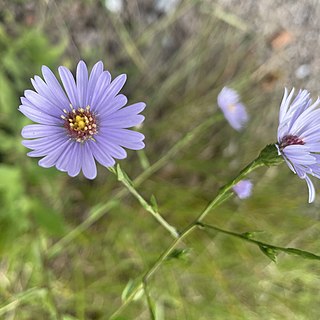
Symphyotrichum rhiannon is a species of flowering plant endemic to a serpentine barren in western North Carolina. It has been given the vernacular Rhiannon's aster and is also known as Buck Creek aster. It is a perennial, herbaceous plant in the family Asteraceae.
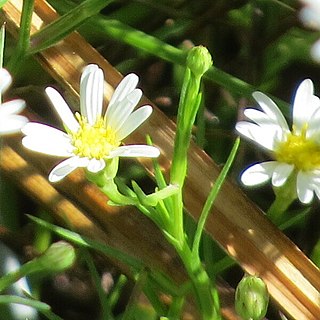
Symphyotrichum potosinum is a species of flowering plant in the family Asteraceae native to Mexico and the U.S. state of Arizona. Commonly known as Santa Rita Mountain aster, it is a perennial, herbaceous plant that may reach heights of 15 to 45 centimeters.
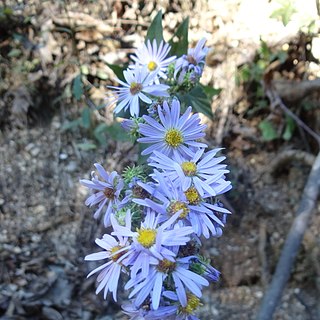
Symphyotrichum anomalum is a species of flowering plant in the family Asteraceae native to Arkansas, Illinois, Kansas, Missouri, and Oklahoma. Commonly known as manyray aster, it is a perennial, herbaceous plant that may reach 20 to 120 centimeters tall. Its flowers have lavender or blue to purple, seldom white, ray florets and cream or light yellow, then pinkish-purple disk florets. Its flowers are attractive to butterflies. The lower leaves have untoothed margins and are heart-shaped at the base.

Symphyotrichum spathulatum is a species of flowering plant in the family Asteraceae native to western North America including northwestern Mexico. Commonly known as western mountain aster, it is a perennial, herbaceous plant that may reach 20 to 80 centimeters tall. Its flowers, which open in July and August, have violet ray florets and yellow disk florets.
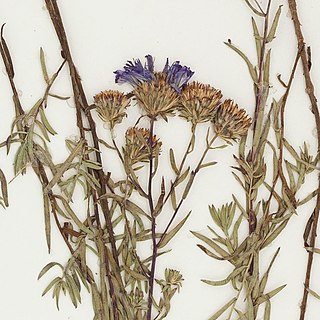
Symphyotrichum turneri is a species of flowering plant in the family Asteraceae native to Durango, Mexico.

Symphyotrichum kentuckiense is a rare species of flowering plant in the Asteraceae family and is commonly known as Kentucky aster, Price's aster, Miss Price's aster, Sadie's aster, or lavender oldfield aster. It is a perennial, herbaceous plant that is endemic to broken limestone cedar glades and roadsides in Alabama, Georgia, Kentucky, and Tennessee. It blooms from August through October, reaches heights between 30 centimeters and 100 cm (3.3 ft), and has green to reddish-brown stems. It is a nearly hairless plant with blue to blue-violet ray florets.

























